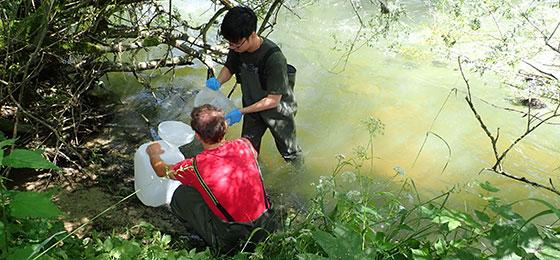Antibiotic Resistance from waste water treatment facilities in Swiss streams and rivers
Researchers show how antibiotic resistance spreads from waste water treatment plants to water bodies - and how the situation could be improved.
Portrait / project description (ongoing research project)
Large quantities of antibiotic-resistant bacteria enter waste water with faeces. Although conventional waste water treatment facilities remove the vast majority of these bacteria, purified waste water is still much more heavily polluted with both resistant bacteria and individual resistance genes than natural bodies of water. As yet, there has been very little research into what happens to these bacteria and genes when the purified water is released into rivers. Researchers at Eawag have therefore investigated how resistance from waste water treatment facilities spreads after purified water is released into watercourses.
High resistance concentrations dilute rapidly – with exceptions
Helmut Bürgmann and his team began by using genetic tests to analyse and compare different habitats within river ecosystems both upstream and downstream of waste water treatment facilities. They found that releasing purified waste water not only increased antibiotic resistance levels in river water, but also that resistant organisms and resistance genes from the waste water find their way into sediments, biofilms on stones, the gut of freshwater crayfish and elsewhere.
To estimate the overall consequences for water systems, the researchers took extensive samples at varying distances downstream from the treatment facilities. These showed that the pollution is limited in range. While it is greatest immediately downstream from the treatment facilities, it declines substantially in a matter of a few kilometres. This is primarily due to dilution processes and secondarily to degradation. However, the researchers also found exceptions: In one river, they occasionally found increased concentrations of resistance genes downstream. This indicates that antibiotic-resistant organisms and resistance genes accumulate and multiply in river systems under certain conditions.
Levels particularly high after heavy rain
Despite an excellent sanitary infrastructure, Switzerland's sewer systems and waste water treatment facilities are repeatedly overloaded, particularly when heavy rainfall creates very large volumes of waste water. Under such circumstances, a mixture of surplus rainwater and untreated waste water that has bypassed conventional treatment processes is released into rivers from overflow chambers and combined waste water overflows. Helmut Bürgmann and his team also took and analysed water samples from rivers during heavy rain. They were able to show that overflow from rainwater and sewer systems leads to a rapid, pronounced increase in antibiotic-resistant organisms and resistance genes in the rivers into which they are discharged. However, the resulting high levels always decline again after several hours.
The researchers estimate that such extreme weather events account for around half of total antibiotic resistance input into rivers in the course of the year, despite only 3 per cent of communal waste water being released untreated into rivers in this way. The Eawag researchers therefore suggest increasing the retention capacity of treatment facilities and retention basins. Similarly, rainwater should be separated from waste water more effectively, while better seepage in treatment facility catchment areas could reduce the amount of water that makes its way into sewer systems during heavy rain.
Prediction models help improve safety and facilitate countermeasures
The researchers are now using the knowledge they have gained to develop models to predict resistance levels in Switzerland's river network. It should be possible to use these models to predict where elevated levels of antibiotic resistance genes will occur. Scientists will also be able to use such models to investigate future scenarios. On the one hand, climate change is expected to bring longer dry periods with correspondingly less diluted waste water and a greater incidence of heavy rainfall events with increasingly frequent and severe sewer system overflows; on the other hand, many treatment facilities will release fewer resistant bacteria thanks to ozonation technologies. Such information is therefore likely to grow in importance going forward; it could help make rivers safe for bathing, irrigation and other purposes while delivering the factual basis for measures to prevent the spread of antibiotic resistance in the environment.
August 2022
Original title
Swiss River Resistome – identity, fate, and exposure

